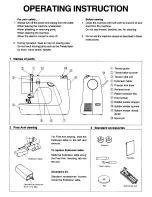
APPLIQUE
Appliqué adds beauty and interest to clothing
and household linens. You can create your
own design, trace a simple outline from a
coloring book, or use a motif cut from a printed
fabric. Fabrics of like or different texture com
bine equally well.
A closely spaced zig-zag stitch is most com
monly used in appliqué work, but decorative
stitch patterns may also be used effectively.
Although you may vary stitch width to accom
modate fabric weave or texture, never allow
the stitch to be too wide.
When appliquéing, make a test sample to help
you decide which of the following two methods
is more appropriate for your fabric and de
sign.
Preparation
• Baste appliqué to fabric.
• Outline appliqué with straight stitching (use
a short stitch).
• Remove basting and press.
• Attach special-purpose foot (and zig-zag
plate).
Method #1 — Trimming after Stitching
1.
Set pattern selector and stitch-width dial
for desired appliqué stitch. Adjust stitch
length in the
FINE
area.
2.
Outline the entire design with appliqué
stitching.
3.
Cut away the fabric on the outer edges of
the stitching with embroidery scissors.
Method #2 — Stitching after Trimming
1. Trim outside fabric edges close to straight-
stitch outline of design.
2.
Set pattern selector and stitch-width dial
for desired appliqué stitch. Adjust stitch
length in the
FINE
area.
3.
Overedge the design with appliqué stitch
ing. This step will produce a smooth, lus
trous finish.
Method #"1 — Trimming after Stitching
Method #2 —Stitching after Trimming
55
Instrukcje obsługi maszyn do szycia firm Polskich jak i zagranicznych np. Singer Toyota Pfaff Gritzner Łucznik Arka
















































